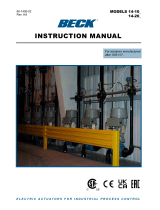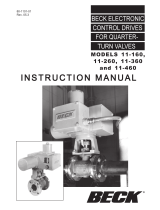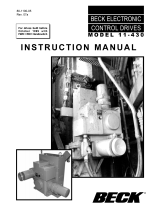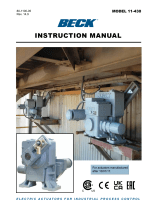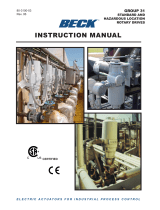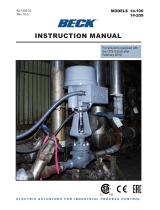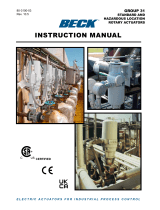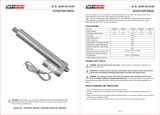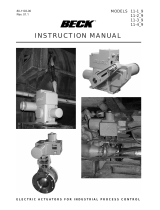Page is loading ...

ELECTRIC ACTUATORS FOR INDUSTRIAL PROCESS CONTROL
80-1400-02
Rev. 07.7
INSTRUCTION MANUAL
14-10_
14-20_
MODELS
R
For actuators built after
January 2000 with RETRACT /
EXTEND Handswitch

2
80-1400-02
This manual contains the in for ma tion
needed to install, operate, and maintain the
Beck 14-100 & 14-200 linear electric actuators,
man u fac tured by Harold Beck & Sons, Inc. of
New town, Pennsylvania.
Group 11 quarter-turn
actuators ...
are designed specifically
for use with ball, plug, and
butterfly valves. Direct-
cou pled, factory-mounted
assemblies are available
from Beck for easy
in stal la tion.
Group 31 rotary
actuators ...
are particularly suited for
coupling to ball, plug, and
butterfly valves up to 4”
(102 mm) di am e ter, and
small damp ers.
The Group 14 actuator is a powerful control
package designed to provide precise position
con trol of globe valves and other devices
re quir ing up to 4,000 lbs (17 800 N) of thrust.
Group 11 rotary actuators ...
provide precise position control of dampers,
quar ter-turn valves, fluid cou plings, and
oth er devices re quir ing up to 1,800 lb-ft
(2 440 N•m) actuator torque.
NOTICE: This manual includes information that will
make installation simple, efficient, and trouble-free.
Please read and understand the appropriate sections in
this manual before attempting to install or operate the
Group 14 actuator.
INTRODUCTION

3
80-1400-02
Product Description ...................................................................................................... 4
General Specifi cations ................................................................................................. 5
Outline Dimension Drawings ........................................................................................ 6
Control Options ............................................................................................................ 8
Installation ...................................................................................................................... 9
Wiring ......................................................................................................................... 11
Wiring Options............................................................................................................ 15
Start-up ...................................................................................................................... 17
Operation ...................................................................................................................... 18
Calibration
Switches ..................................................................................................................... 22
Stroke Change ........................................................................................................... 24
Changing Direction of Travel ...................................................................................... 25
Feedback Signal ........................................................................................................ 26
Demand Signal........................................................................................................... 30
Maintenance
Routine ....................................................................................................................... 32
Component Replacement .......................................................................................... 33
Troubleshooting ............................................................................................................ 36
Appendix
Spare Parts & Components ....................................................................................... 39
Control Assembly ....................................................................................................... 40
CPS-2 Data ................................................................................................................ 44
CPS-2 Functional Block Diagram............................................................................... 45
Schematics................................................................................................................. 46
Index .............................................................................................................................47
Services .......................................................................................................... Back cover
TABLE OF CONTENTS

4
80-1400-02
Beck Group 14 linear actuators are en gi neered
for precise, reliable operation of globe valves
requiring up to 4,000 lbs (17 800 N) of thrust. The
cool, stable operation of Beck’s control motors
cou pled with the powerful gear train provide the
tight, re spon sive control required by modern
con trol loops to keep operating costs low. The
motor can withstand occasional accidental stalls
of up to four days without failure, and will resume
instant response to control signals immediately
upon re mov al of the condition. Mechanical stops
on the output shaft prevent over-travel.
An easy-to-turn, spoke-free Handwheel is
in cor po rat ed into the Group 14 design to allow
man u al operation during installation or power
out ag es. The Handwheel can be used to open
and close valves smoothly and easily under full
load conditions.
The Beck Tight-Seater™ coupling is a part
of the Group 14 actuator. This preloaded disk
cou pling is mounted on the actuator output shaft
and provides positive seating of the valve plug
up to the rated thrust of the drive. It eliminates
high-pressure leakage, which can cause erosion
of the valve seat. A patented self-locking
mech a nism holds the actuator output shaft in
position when the motor is de energized.
A Calibar index allows simple, single-point
ad just ment of the length of the stroke to match
valve requirements. When this adjustment is
made, the position feedback signal, end-of-travel
limit switch es, and any auxiliary switches are all
au to mat i cal ly adapted to the new stroke setting.
TABLE 1:
GROUP 14 MECHANICAL AND ELECTRICAL SPECIFICATIONS
Valves may also be operated at their in di vid u al
locations with a built-in electric Hand switch.
Beck’s ESR-4 Electronic Signal Receiver
pro vides precise actuator control from either
con ven tion al analog or computer-based control
systems.
Beck’s CPS-2 Contactless Position Sensor
pro vides accurate position feedback in de mand ing
environmental conditions, with no contacting or
wiping surfaces to wear or intermittently lose
con tact.
Beck Group 14 electric actuators are
designed with individual weatherproof enclosures
to protect the main components.
Although the Group 14 actuator is normally
in stalled in the upright position, the actuators may
be installed in any orientation. For installations
where the piping will not support the weight of
the actuator, holes are provided for mounting
hard ware.
TYPICAL APPLICATIONS
Beck Group 14 electric actuators are suit able
for steam fl ow control, combustion gas con trol,
and any other application that requires pre cise
valve position control. An actuator may be
ap plied to any globe, cage, or diaphragm valve
with a rising stem that has a stroke within the
ca pa bil i ty of the actuator. An integral mounting
yoke is part of each actuator.
Beck Group 14 actuators are available in
stroke ranges from 5/16” (7.9 mm) to 4 1/2”
(114.3 mm), and in a variety of thrust and timing
combinations. See Table 1 for thrust and timing
options.
Basic
Model
Thrust
(lbs. / N)
Timing -- sec./in. (sec./cm.) Dimensional
Data
@ 60 Hz @ 50 Hz
14-100
340 / 1 513 4 (1.6) 5 (2)
Pages 6 & 7
425 / 1 891 11 (4.3) 13 (5.1)
600 / 2 670 16 (6.3) 19 (7.5)
650 / 2 893 8 (3.1) 10 (3.9)
800 / 3 560 11 (4.3) 13 (5.1)
1,000 / 4 450 27 (10.6) 32 (12.6)
1,100 / 4 895 16 (6.3) 19 (7.5)
1,620 / 7 209 48 (18.9) 57 (22.4)
1,800 / 8 010 27 (10.6) 32 (12.6)
14-200 2,700 / 12 015 16 (6.3) 20 (7.9)
4,000 / 17 800 24 (9.4) 29 (11.4)
PRODUCT DESCRIPTION

5
80-1400-02
Model 120 V ac 240 V ac
Max. Current 14-100 .56 A 72 W .33 A 80 W
and Power 14-200 1.5 A 180 W .86 A 210 W
Operating Temperature -40 to 85°C. (-40 to 185°F.)
0 to 99% relative humidity
Demand Signal
Electronic Signal Receiver 0–5 mA
(ESR-4) 1–5 mA
4–20 mA
10–50 mA
1–5 V dc
-10 to 10 V dc
Demand Signal Span Adj. 2 to 18 V dc
Demand Signal Zero Adj. -100 to 275% of span
(except -10 to 10 V dc)
Split Signal Range 4–12 mA
12–20 mA
Deadband 0.6% of span
Sensitivity 25% of deadband
Direct AC Control 120 V ac for 2-position, multi-
position or modulating V ac
control.
Feedback
Contactless Position Sensor (CPS-2)
Feedback Signal 1–5 mA
4–20 mA
10–50 mA
1–5 V dc
0–16 V dc
-10 to 10 V dc
Output Stability for 0.25% of span from 102 to 132 V ac
V ac Input Power
Output Stability for ±0.03%/°C. of span for 0 to 50° C.
Temperature Change ±0.05%/°C. of span for -40 to 85° C.
Linearity ±1% of span *
Hysteresis 0.25% of span at any point
Isolation Max. leakage of 10μA at 60 V rms,
60 Hz from output to ground
Film Potentiometer 1,000 ohms
Max. Voltage 40 V
Wattage 2 watts max.
Linearity ±0.5% *
Max. Wiper Current 1 mA
Input Power 120 V ac single phase 50 or 60 Hz; 48, 72 or 180 watts Allowable Tolerance
240 V ac single phase 50 or 60 Hz +10%, -15%
Action on Loss of Power Stays in place.
Action on Loss of Input Stays in place or moves to full travel or zero position. actuators to any preset position with
Signal (Power On) optional switch assembly on Models 14-_07 and 14-_08. Field adjustable.
Stall Protection and If the motor tries to run in one direction for more than 300 seconds, the Stall Protection
Annunciation (14-200 standard, Module shuts off power to the motor and a solid state relay will change state. The relay
14-100 optional) is rated for 120 V ac or dc, 10 VA.
Limit Switches Two SPDT, one for fully retracted and one for fully extended limit of travel.
Auxiliary Switches Up to four 6A, 120 V ac switches available.
Switches are labeled S1 to S4 and are cam operated, fi eld adjustable.
S1 and S4 are set to operate just before reaching fully extended travel limit.
S2 and S3 are set to operate just before reaching fully retracted travel limit.
Handswitch Permits local electrical operation, independent of controller signal. Standard on all units.
An optional auxiliary contact can be used to indicate that the Handswitch is in AUTO
mode. Contact rated at 2.5 A, 125 V ac.
Handwheel Provides manual operation without electrical power.
Motor 120 V ac, single phase, no burnout, non-coasting motor has instant magnetic braking.
Requires no contacts or moving parts. Can remain stalled for 4 days without failure of
motor or gearing.
Gear Train High effi ciency, precision cut steel and ductile iron gears and bronze nut.
Interchangeable gear modules permit fi eld change of timing.
Mechanical Stops Prevent overtravel during automatic or manual operation.
Enclosure Precision machined aluminum alloy castings, painted with corrosion resistant polyurethane
paint, provides a rugged, dust-tight and weatherproof enclosure. Type 4; IP66.
Stroke Adjustment Calibar simultaneously adjusts the stroke length, position feedback signal, limit switches
and auxiliary switches. The new stroke displacement is produced by the full demand
signal.
Standards CSA listed; CE compliant
* Electrical linearity. Actual feedback relative to output shaft position varies with shaft position up to 15% at the center of stroke range.
Consult factory for details.
PRODUCT DESCRIPTION General Specifi cations

6
80-1400-02
OUTLINE DRAWING -- 5/16 [8] to 2 1/8 [54] travel (Dimensions in inches & [mm] )
Beck Model 14-100 & -200
NOTE: Actuators may be mount ed in any ori en ta tion.
Beck
Model
No.
Drive Shaft
Travel Range
(in) [mm]
"A"
Valve Boss
Dia. Range
(in) [mm]
"B"
Yoke
Height
(in) [mm]
"C"
Nominal Drive
Shaft Extension
(in) [mm]
Max. Valve Stem
Extension (Valve
Stem Retracted
(in) [mm]
Approx.
Weight
(lb) [kg]
14-100 5/16–1 3/4 [8–44] 1–2 5/8 [25–67] 8 [203] 4 3/16 [106] 5 1/2 [140] 80 [36]
3/4–2 1/8 [19–54] 1 3/8–3 3/4 [35–95] 13 1/2 [343] 6 [152] 9 1/4 [235] 92 [42]
14-200 5/16–1 3/4 [8–44] 1 3/8–3 3/4 [35–95] 13 1/2 [343] 6 11/16 [170] 9 [229] 105 [48]
3/4–2 1/8 [19–54]
MODEL 14-100MODEL 14-200
PRODUCT DESCRIPTION Outline Dimensions

7
80-1400-02
OUTLINE DRAWING -- 3/4 [19] to 4 1/2 [114] travel (Dimensions in inches & [mm] )
NOTE: Actuators may be mount ed in any ori en ta tion.
Beck Model 14-100 & -200
Beck
Model
No.
Drive Shaft
Travel Range
(in) [mm]
"A"
Valve Boss
Dia. Range
(in) [mm]
"B"
Yoke
Height
(in) [mm]
"C"
Nominal Drive
Shaft Extension
(in) [mm]
Max. Valve Stem
Extension (Valve
Stem Retracted
(in) [mm]
Approx.
Weight
(lb) [kg]
14-100 3/4–3 1/2 [19–89] 1 3/8–3 3/4 [35–95] 19 13/16 [503] 12 5/16 [313] 9 1/4 [235] 100 [45]
1 3/4–4 1/2 [44–114] 19 13/16 [503] 12 5/16 [313] 9 1/4 [235] 100 [45]
14-200 3/4–3 1/2 [19–89] 1 3/8–3 3/4 [35–95] 19 13/16 [503] 13 [330] 9 1/4 [235] 113 [51]
1 3/4–4 1/2 [44–114]
MODEL 14-100MODEL 14-200

8
80-1400-02
TABLE 2:
SUMMARY OF GROUP 14 CONTROL OPTIONS
PRODUCT DESCRIPTION Control Options
MODEL
NO.
CONTROL
TYPE
INPUT
SIGNAL ESR-4 PART NO.* FEEDBACK
DEVICE
EXTERNAL
OUTPUT
SIGNAL
CPS-2 PART NO.*
AUXILIARY
SWITCH
OPTIONS
Electronic
Modulating
0–5 or
1–5 mA 13-2246-02
CPS-2
Contactless
Position
Sensor
4–20 mA 20-4400-12
None,
2,
4,
2+INTLOS
1–5 V dc 20-4400-13
16 V dc or
50 mA max. 20-4400-13
14-__8
4–20 mA 13-2246-03
10–50 mA 13-2246-04
1000 ohm
Potentiometer
20-3060-03
None,
1000 ohm
Aux. Pot.
n/a
None,
2,
4,
2+INTLOS
0–10 V dc 13-2246-07
14-__7 1–5 V dc 13-2246-05
-10–10 V dc 13-2246-08
Direct
AC Control
(Modulating)
120 V ac None
CPS-2
Contactless
Position
Sensor
4–20 mA 20-4400-02
None,
2,
4
1–5 V dc 20-4400-03
16 V dc or
50 mA max. 20-4400-03
14-__6
Low Power
120 V ac
13-2245-50
(Relay Board)
Low Power
dc
13-2245-51
(Relay Board)
120 V ac None
1000 ohm
Potentiometer
20-3060-03
1000 ohm
Pot.
n/a
None,
2,
4
14-__5 Low Power
120 V ac
13-2245-50
(Relay Board)
Low Power
dc
13-2245-51
(Relay Board)
5 Position
120 V ac n/a None None
None
14-__4 4 Position
3 Position None,
2
2 Position
Open/Close
None,
2,
4
14-__3
*ESR-4 series 13-2246-XX boards replace 13-2245-XX series boards.
CPS-2 series 20-4400-XX boards replace 20-3400-XX series boards.

9
80-1400-02
SAFETY PRECAUTIONS
WARNING
WARNING
Installation and service instructions
are for use by qualifi ed personnel
only. To avoid in ju ry and elec tric
shock, do not perform any
servicing other than that contained
in this man u al. Please read
and understand the appropriate
sections in this manual before
attempting to install or operate your
actuator.
STORAGE INFORMATION
The actuator should be stored in its shipping
car ton in a clean, dry area.
If it is necessary to store the actuator outdoors
for a long period of time, it should be removed
from its shipping carton and stored above ground.
A waterproof cover should be securely fastened
over it. Do not stack actuators on top of one
an oth er. Stored actuators should be periodically
checked to make sure no condensation has
formed in the con trol compartments. Damage
due to moisture while in storage is not covered by
warranty.
UNPACKING
Group 14 actuators are packed in
standardized card board shipping containers.
actuators mount ed on valves may be packed in
cardboard con tain ers or strapped to a skid and
crated, depending on size. After unpacking, the
wooden platform may be used to transport the
actuator to the installation site.
INSTALLATION—MECHANICAL
Beck actuators can be furnished with valves
mount ed as unitized assemblies ready for
pipe line installation.
CAUTION
Working with valves installed in a
pipeline can be dangerous. Take
appropriate precautions when
mounting to installed valves.
Figure 1
Mounting the Actuator on a Valve
Refer to Figure 1, below, to identify the
mount ing parts and the steps to install the
actuator onto the valve.
1. Prepare the valve. It may be necessary to
re move parts that are no longer used or to
re place or adjust packing. Refer to the valve
main te nance manual for specifi c instructions.
Consult the Beck Valve Mounting Spec i fi ca tion
sheet that was shipped with the actuator for
any instructions re gard ing modifi cations to
the valve stem that may be nec es sary.
2. Push the valve stem (11) into the valve body
to the fully seated or stem down position.
3. Move the G-14 output shaft (5) up into the
actuator body until the upper mechanical stop
(3) is tight against the lower bearing plate (1).
4. Remove the four lower bearing plate bolts
(2) that hold the bottom plate to the actuator
body (1/2" bolt heads). Pressure from the
me chan i cal stop will hold the plate in place
when the bolts are re moved. Bolt the yoke
(9) to the low er bear ing plate using the longer
bolts sup plied with the yoke. Torque bolts to
10 Ib-ft (14 N•m). Continued
INSTALLATION
4
0
1
2
3
12
3
5
7
8
10
4
6
9

10
80-1400-02
5. Place the jam nut (7) and travel index (6)
over the valve stem (11) before mounting the
actuator on the valve.
6. Remove the boss nut (8) from the valve and
place the actuator and yoke over the stem
and onto the boss (12). Secure the yoke with
the boss nut, fi nger-tight.
7. Using the actuator Handwheel, lower the
actuator out put shaft to contact the valve
stem. Thread the valve stem into the end
of the actuator output shaft. HINT: Rotate
the whole yoke /drive as sem bly to get the
valve stem started into the actuator out put
shaft. Continue lowering the actuator output
shaft and threading the valve stem until the
actuator output shaft is fully down on the
me chan i cal stop.
8. Tighten the boss nut to secure the yoke and
tighten the yoke set screw (10).
9. Follow the valve seating adjustment pro ce dure
on page 17 to complete the mounting.
Removing the Actuator from a
Valve
1. Move the Group 14 output shaft up into the
actuator body until the mechanical stop (3) is
tight against the lower bearing plate (1).
2. Turn off all electrical power and disconnect all
electrical wiring from the drive.
3. Loosen the valve stem jam nut (7). Loosen
the boss nut (8) on the yoke and leave it
fi nger tight. Loos en the yoke set screw (10).
4. Unthread the valve stem from the actuator
output shaft by turning the whole yoke / actuator
as sem bly.
Valve Installation
The Beck control actuator can be mounted in
any con ve nient orientation. There is no preferred
op er at ing position.
Inspect the valve body to be sure that it is
clean. Be certain that other pipelines in the area
are free from pipe scale or welding slag that
could dam age the gasket surfaces.
Tighten the flange bolts and ensure that
all bolts are evenly torqued. Refer to the
gasket man u fac tur er’s instructions for specifi c
in for ma tion on tightening fl ange bolts.
NOTE: The valve may have experienced
tem per a ture variations in shipment. This
could result in seepage past the stem seals.
Refer to the valve manufacturer’s main te nance
in struc tions for packing adjustments.
INSTALLATION—ELECTRICAL
Two conduit connections are provided in
ev ery Beck Group 14 actuator for supplying
power and sig nal wiring to the unit. A sealant
must be used on threaded conduit connections
to keep mois ture out. Conduit should be routed
from below the actuator so that condensation and
other con tam i nants entering the conduit cannot
enter the drive.
To maintain signal integrity and meet most
electrical codes, power and signal wires must
be routed to the actuator separately. The signal
wiring should be either shielded cables or be
installed in conductive conduit and/or cable trays.
A large, clearly labeled terminal block on the
side of the actuator is enclosed in a gasketed
metal en clo sure. Terminals will accommodate
up to 12 AWG (3.31 mm2) wiring (see Figure 2,
page 11).
CAUTION
Always close covers immediately
after installation or service to
prevent moisture or other foreign
matter from entering the actuator.
Refer to the wiring diagram furnished with
your Beck actuator for proper AC power and
signal con nec tions. It is advisable to provide
normal short circuit protection on the AC power
line. A copy of the wiring diagram is shipped with
each actuator and is fastened to the inside of the
terminal block cov er. If there is no wiring diagram
avail able, you may obtain a copy from Beck by
pro vid ing the se ri al number of your drive.
Your Beck actuator has been supplied to
match the signal source in your control loop. If
it does not match, refer to the Demand Signal
Options sec tion of this manual, page 15, for
information on how to change the demand signal.
For maximum safety, the Beck actuator body
should be grounded. Normally, the electrical
con duit pro vides adequate ground protection.
If not, a sep a rate ground conductor should be
con nect ed to the actuator body.
M , ’.
INSTALLATION

11
80-1400-02
The Group 14 actuator is available with
six sep a rate con trol configurations which are
provided to match the control requirements
for your system. Typical func tion al wiring
connections for each con trol op tion are described
in the following para graphs and diagrams. The
wiring diagram spe cif ic to each actuator is
attached to the inside of the wiring terminal cover.
Feedback connections for actuators incorpor-
ating the Contactless Position Sensor (CPS-2)
for con trol options 6 and 8 are described on
pages 13 and 14.
A Group 14 actuator can be ordered with
up to four op tion al aux il ia ry switches. Wiring
con nec tions for these are described on page 22.
To enable full Handswitch operation, connect
a 120 V ac line to terminal C (jumper between
ter mi nals A and C).
Option 8, Modulating
Analog Position Control with
Contactless Position Sensing
Customer must supply two wires to power the
drive: One 120 V ac line (terminal C), and one
neu tral (terminal B). Customer must supply two
wires for the modulating analog control signal:
Connect to terminal AA (+) and to terminal BB(-).
Customer may supply two additional wires to
mon i tor the analog position feedback signal (see
pag es 13 and 14 for connections). The actuator's
feed back circuit power supply is derived from the
120 V ac line, therefore the feedback sig nal must
be wired to a “4-wire” type non-powered analog
input.
Figure 2
The wiring diagram at
right is a typical ex am ple of
an Option 8 actuator with
a Stall Pro tec tion Mod ule
in stalled.
INSTALLATION Wiring

12
80-1400-02
Option 6, Modulating
Direct AC Control with Contactless
Po si tion Sens ing
Customer must supply three wires to directly
con trol the actuator motor direction: One 120
V ac line for Retraction (terminal M), one 120
V ac line for Extension (terminal N), and one
neutral (ter mi nal B). Cus tom er may supply two
additional wires to mon i tor the analog position
feedback sig nal (see pages 13 and 14 for
connections). If po si tion feed back monitoring is
desired, a 120 V ac line must be con nect ed to
terminal C. The actuator's feed back cir cuit power
supply is derived from this 120 V ac line, so the
feedback sig nal must be wired to a “4-wire” type,
non-powered an a log in put.
Option 5, Modulating
Direct AC Control with Potentiometer
Position Sens ing
Customer must supply three wires to directly
con trol the actuator motor direction: One 120 V
ac line for Retraction (terminal M), one 120 V ac
line for Extension (terminal N), and one neutral
(ter mi nal B). The position feedback potentiometer
con nec tions are available at terminals CC
(Re verse), DD (Wip er), and EE (Forward).
Option 7, Modulating
Analog Position Control with
Potentiometer Position Sensing
Customer must supply two wires to power the
drive: One 120 V ac line (terminal C), and one
neu tral (terminal B). Customer must supply two
wires for the modulating analog control signal:
Connect to terminal AA (+) and to terminal BB (-).
If position feedback monitoring is required, an
op tion al auxiliary potentiometer can be ordered.
The optional auxiliary potentiometer connects
to ter mi nals CC (Reverse), DD (Wiper), and
EE (For ward) and is compatible with standard
“slidewire” style inputs.
Option 8, Modulating without
External Feedback Signal
Analog Position Control with
Contactless Position Sensing
Customer must supply two wires to power the
drive: One 120 V ac line (terminal C), and one
neu tral (terminal B). Customer must supply two
wires for the modulating analog control signal:
Con nect to terminal AA (+) and to terminal BB(-).
INSTALLATION Wiring

13
80-1400-02
CPS-2 SIGNAL CONNECTIONS
Beck Group 14 actuators equipped with the
Contactless Position Sensor (CPS-2) are shipped
ready for in stal la tion. They are en gi neered to
match the mA or V dc feedback range in your
sys tem.
Customer connections for feedback signal
wir ing on each CPS-2 model are described in
the fol low ing diagrams and paragraphs. Refer to
Ta ble 11, page 46, for output signal rang es, out put
terminals, range chang ing re sis tance val ues, and
terminals to which the rang ing resistor or jump er
is con nect ed.
To verify that the feedback signal range
is cor rect for your drive, connect a mA / V dc
mul ti m e ter across the appropriate terminals
(check model number on CPS-2 transformer
and Table 11, page 46, for correct terminals CC,
DD, or EE). Use the Handswitch to operate the
actuator throughout its full travel.
NOTE: Ranging resistors must be con nected
to the control actuator output ter minals. If
a rang ing resistor change is required, it
may be obtained locally. If resistors with
±1% tol er ance are not available, they can be
or dered from Beck.
Option 3, Open / Close
Direct AC Control
Customer must supply three wires to directly
con trol the actuator motor direction: One 120 V
ac line for Retraction (terminal M), one 120 V ac
line for Extension (terminal N), and one neutral
(ter mi nal B).
240 V ac Operation
All of the options described above are
avail able for 240 V ac operation instead of 120
V ac op er a tion. In all cases, the power neutral is
Option 4, Multi-Position
Direct AC Control with Cam-Operated
Switches to Stop actuator Travel
Customer must supply three wires to directly
con trol the actuator motor direction: One 120
V ac line for Retraction (terminal M), one 120
V ac line for Extension (terminal N), and one
neutral (ter mi nal B). Up to fi ve intermediate stop
positions may be spec i fi ed, each requiring an
additional 120 V ac line.
re placed with Line 2 of the 240 V ac, and the 120
V ac line is replaced with Line 1 of the 240 V ac.
CPS-2 Model 20-4400-02, -12
Ter mi nal Con nec tions
1. A single 4–20 mA current output is available
be tween terminals EE (+) and CC (-) when
driv ing into an external load between 250 and
800 ohms. No ranging resistor is required.
2. 4–20 mA output is also available across EE
(+) and DD (-); 500 ohms is the maximum
external load (for larger loads see Item 1
above).
4-20 mA Signal Output
CC
DD
EE
-------
-------
–
+
4–20 mA
CC
DD
EE
-------
-------
-------
–
+4–20 mA

14
80-1400-02
CPS-2 Model 20-4400-03, -13
Volt age Feedback
Terminal Connections
The universal model has a voltage divider
net work which allows for various voltage signal
rang es. Voltage output ranges are available
across terminals EE (+) and CC (-) with the prop er
ranging resistor connected across ter mi nals CC
and DD.
Units are factory-calibrated for specified
sig nal rang es and are provided with proper
ranging re sis tors installed. Other voltage ranges
are at tain able by adding a ranging resistor across
ter mi nals CC and DD.
The ranging resistor value is given in Table
11, page 46, or can be calculated using the
equa tion:
Where R = Resistor connected from CC to DD
V = Output voltage span
If converting to a zero-based range (a range
that includes zero as an end point), refer to
“Ad just ing the Zero Potentiometer” Section, page
28. Voltage Output
CPS-2 Model 20-4400-03, -13
Current Feed back
Terminal Connections
The universal model has current sensing
ter mi nals, which allow for various current signal
rang es. Current output is available between
ter mi nals DD (+) and CC (-) with the proper ranging
resistor connected across terminals DD and EE.
Units are factory-calibrated for specifi ed sig nal
rang es and are provided with proper resistors
in stalled.
The ranging resistor value is given in Table 10,
page 46, or can be calculated using the fol low ing
equation:
Where R = Resistor (Ohms) Connected from
DD to EE
I = Output Current Span (Amp)
If converting to a zero-based range (a range
that includes zero as an end point), refer to
“Ad just ing the Zero Potentiometer” section, page
28. Current Output
INSTALLATION Wiring

15
80-1400-02
DEMAND SIGNAL OPTIONS
Beck Group 14 actuators configured for
milliamp or dc analog modulating applications
include an Elec tron ic Signal Receiver (ESR-4).
Several con trol options are available with the
ESR-4, such as op er at ing more than one actuator
with a single signal source.
The instructions below apply to applications
that require a signal change or to situations
call ing for operation of multiple actuators from a
com mon demand signal.
Demand Signal Range Change
If it is necessary to change the range of an
ESR-4 board to receive a diff erent demand signal
cur rent, the “R-in” resistor must be changed. See
Table 3, below, for the proper value, and Fig ure
11 on page 31 for its location on the board. It is
mount ed on turrets to facilitate the change. After
soldering the new resistor in place, recalibrate in
accordance with the instructions on page 30. If
a prop er resistor with ±1% tol er ance cannot be
ob tained locally, it can be or dered from Beck.
Series Operation
Beck actuators can be connected in series
from the same signal for concurrent operation.
Care must be taken to keep the polarity correct
in each actuator's input terminals. Two or three
actuators may usually be connected in series.
The number of actuators that may be connected
in series is limited only by the controller’s (signal
source) capability to feed current into the total
resistance of the cir cuit involved. Consult the
controller man u fac tur er’s recommendations.
No change is required to the actuator's cali-
bration for series operation. An interruption in the
circuit will actuate loss of demand signal (L.O.S.)
on the actuators in the circuit.
Parallel Operation
Beck actuators can be connected in parallel
to the same signal for concurrent operation. Up
to four actuators may be connected in parallel.
For parallel operation, use ESR-4 board no.
13-2246-05 in each drive, and add a shunting
re sis tor across input terminals AA and BB on one
of the Beck drives. The value of the resistor is:
Where N = the number of drives.
Refer to Table 3, below, for the input resistance.
For ex am ple, a 278 ohm shunting resistor should
be used for four actuators in parallel with a 4–20
mA demand signal. If the re sis tance calculation
is not a standard value, then se lect the nearest
standard value.
A minor span adjustment is required for each
actuator in a parallel circuit. An interruption in the
cir cuit to one actuator will not prevent the other
actuators from functioning, but there will be a
slight cal i bra tion shift.
TABLE 3:
ESR-4 BOARD MODELS
INPUT
SIGNAL
ESR-4
BOARD PART NO.
CHANGES FROM
13-2246-03
R-in VALUE
(TOLERANCE 1%)
NET CIRCUIT
INPUT RESISTANCE
0–5* or
1–5 mA dc 13-2246-02 Remove J10 1.05K ohms 1K ohms
4–20 mA dc** 13-2246-03 None 255 ohms 250 ohms
10–50 mA dc 13-2246-04 Remove J11 and
add R-in4 R-in4 = 100 ohms 100 ohms
1–5 V dc** 13-2246-05 Remove J9 20K ohms 10K ohms
0–10 V dc** 13-2246-07 Remove J1 and J9 20K ohms 10K ohms
-10 to 10 V dc 13-2246-08 Remove J1, J2,
J6, J7, J8 & J9 20K ohms 50K ohms
*Span and zero adjustment required.
**Standard ISA range (S 50.1/1975).
INSTALLATION Wiring Options

16
80-1400-02
Split Range Operation
Two or three Beck actuators may be
operated over their full range by a portion of
the controller’s out put signal range. The most
common arrangement involves two actuators
operating on equal halves of the demand signal
range. For ex am ple, if a 4–20 mA control signal
is used, the fi rst actuator would move 100% of
its stroke on a signal range of 4–12 mA, while
the second operates on the 12–20 mA portion of
the signal. In this case, the ESR-4 boards are
the same as would be used for parallel operation
(13-2245-05), but calibrated to the range required
for each drive. A shunting re sis tor must be added
across input terminals AA and BB on one of the
Beck actuators to produce a 2.0–6.0 volt span
across each board for its ac tive por tion of the
range. For a 4–20 mA range three- way split,
the shunting resistor range would be 425–1,650
ohms.
Follow the steps for calibrating the demand
signal, page 30, for each actuator unit, using
half span val ues for the demand signal. Use the
proper start ing point for each half-range when
setting the zero, 4 mA and 12 mA. Before setting
the zero on the sec ond actuator (12 mA), cut one
lead of resistor R35 on the ESR-4 board. See
Figure 11, page 31, for location of R35.
In a split range configuration, connect
terminals E and F (L.O.S. wire) to prevent
un des ired “stay-in-place” operation of the second
or third actuator due to fast, downward signal
chang es.
When three actuators are to be operated
on equal portions of the demand signal, the
4–20 mA range would split into 4–9.33 mA,
9.33–14.67 mA, and 14.67–20 mA signals. A 487
ohm shunting re sis tor (Beck P/N 13-2510-03) is
adequate. Pro ceed as in the case of the two-way
split, first set ting span, then the zero. When
setting the ESR-4 board in the fi rst drive, set the
zero at 4 mA. Then, on the second drive, cut
the R35 re sis tor on the board and set its zero
at 9.33 mA. Before setting zero in the board
of the third drive, short out the R34 re sis tor by
adding a jumper, ad just its zero to 14.67 mA,
cut resistors R35 and R36 from the board, then
remove the jumper from R34. Check op er a tion
of all actuators by running the demand signal
through its complete range. If it is nec es sary to
recalibrate the same board later, you may jumper
resistors R35 and R36 by con nect ing the R35
tur rets together.
INSTALLATION Wiring Options

17
80-1400-02
START-UP INSTRUCTIONS
After the actuator is mounted and its wiring
con nec tions are made, it is ready to be tested for
prop er operation.
Turn on the power supply. Operate the
actuator with the Handswitch and run it through
its full stroke, both directions. Observe that the
driven device travels through its desired stroke.
If sat is fac to ry, set Handswitch at the “auto”
po si tion.
If the actuator is to be operated with automatic
control, turn on the controller and operate the
actuator by varying the control signal. Check
that the valve strokes in the proper direction
for a change in control signal. An increasing
control signal re tracts the shaft and opens the
valve. With a 100% signal, the actuator is fully
retracted. If the valve does not stroke in the
proper direction, first check for proper wiring
connections and verify the control signal at the
drive. If the wiring is correct, then reverse the
direction of travel (see page 25).
If the actuator is to be push-button actuated,
(op tions 3, 4, 5 or 6) operate the actuator using
the Hand switch and observe that direction of
trav el is correct. When travel of the driven
device is sat is fac to ry with reference to the control
sig nal or the push-buttons, the unit is ready for
op er a tion.
Valve Seating Adjustment
The actuator has a Tight-Seater™ attached
to its out put shaft. The Tight-Seater™ allows
tight seat ing of the valve plug. It is a pre-loaded
cou pling that allows the valve plug to seat
before the actuator reaches its lower limit. The
additional amount of travel compresses the
thrust discs in side the Tight-Seater™, causing a
controlled amount of thrust to hold the valve plug
on its seat when the actuator stem reaches its
lower limit. The Tight-Seater™ is factory-set to
produce a thrust matched to the valve and should
never be dis as sem bled. Control of the amount of
valve stem thread ed into the Tight-Seater™ may
be used to adjust the valve seating.
If readjustment of valve seating is necessary,
pro ceed as follows:
1. With the Handswitch, run the actuator to a
po si tion above the 0% or lower limit position.
2. Loosen the lock nut on the valve stem and
thread the valve stem into the Tight-Seater™.
3. Run the actuator to the 0% position, using the
Hand switch.
4. Thread the valve stem out of the Tight-Seater™
until the plug seats in the valve.
5. Raise the actuator shaft using the Handswitch
un til the plug is clear of the seat and there is
suf fi cient clearance to make the following
ad just ment.
6. Thread the valve stem out of the
Tight-Seater™ a fraction of a turn according
to the valve stem thread as listed (1/32"
trav el):
Thread Turn
3/8-24 3/4
7/16-18 5/8
1/2-20 5/8
3/4-16 1/2
7. Tighten the lock nut and index disc on the
valve stem.
8. Run the actuator to its lower limit using the
Hand switch. The valve stem should stop
before the actuator shaft stops.
9. Reposition the travel index.
CAUTION
If the valve stem is threaded directly
into the actuator shaft without
a Tight-Seater™, the valve stem
should be at least 1/4 turn from
the seat ed plug position when the
actuator shaft reach es the lower
limit. This will prevent dam age
to the valve stem or seat. Do not
at tempt to obtain tight shut-off
with out a Tight-Seater™ as se ri ous
valve dam age may result.
INSTALLATION Start-Up

18
80-1400-02
HOUSING
All models of the Beck Group 14 electric
actuator have individual, cast aluminum
com part ments for the main components: The
con trol mo tor, wir ing ter mi nal board, actuator
train, elec tron ic sig nal re ceiv er, and feedback
section. Gas ket ed cov ers and sealed shafts
make this prod uct ide al ly suited to outdoor and
high-humidity en vi ron ments.
CONTROL MOTOR
The Beck control motor is a synchronous
in duc tor motor that operates at a constant speed
of 72 RPM in synchronism with the line fre quen cy.
Motors are able to reach full speed within 25
mil li sec onds and stop within 20 milliseconds; actual
starting and stopping times will vary with load.
Beck motors have double grease-sealed
bear ings and require no maintenance for the life
of the motor.
DRIVE TRAIN
The Group 14 drive train consists of a control
mo tor, SLM, Handwheel, reduction gears, main
gear, and power screw output shaft. The ductile
iron main gear and the bronze nut and stainless
steel power screw output shaft are common to
units of a particular range of thrust and timing.
The steel reduction gears are part of the fi eld
change able gear hous ing assembly. Diff er ent
com bi na tions of output gear, housing as sem blies,
and motors determine the actuator’s output thrust
and timing.
The output shaft travel is limited by
me chan i cal stops. The mechanical stop for
the ful ly ex tend ed or lower limit of the output
shaft travel is not ad just able. The position of
the retracted or upward travel mechanical stop
is determined by the num ber of washers on the
output shaft be tween the Tight-Seater™ and the
lower bear ing plate. This is factory-set for the
amount of trav el spec i fi ed at the time of the order
and is gen er al ly not changed in the fi eld.
Output shaft travel is de ter mined by the
setting of the Calibar. Mov ing the Calibar block
away from the output shaft in creas es the radius
where the ball bear ing con tacts the sector gear
lever. The longer the ra di us the longer the vertical
stroke of the out put shaft for the same amount of
rotation of the con trol end shaft. There fore, the
Calibar changes the output shaft travel but makes
it unnecessary to change the switch cams, fi lm
potentiometer, or CPS-2. Field Calibar adjustment
is gen er al ly used to shorten the travel. Consult the
fac to ry if a longer stroke is required.
SELF-LOCKING
MECHANISM (SLM)
An integral part of every Group 14 control
mo tor is the self-locking mechanism. This
me chan i cal de vice couples the motor to the
gear train and trans mits full motor torque when
rotated in either di rec tion. When the motor is
de-energized, it in stan ta neous ly locks and holds
the output shaft in position.
TIGHT-SEATER™
The Beck Tight-Seater™ assembly is a pre-
loaded coupling that is installed between the
actuator output shaft and the valve stem. It
produces a controlled positive pressure against
the valve seat, independent of actuator thrust.
The Tight-Seater™ consists of four parts: A
housing attached to the output shaft, linear thrust
discs contained in the housing, a fl anged coupling
attached to the valve stem, and a threaded ring
to contain the fl anged coupling in the housing
and to allow adjustment of the pre-load on linear
thrust discs.
The factory pre-load, by a threaded ring,
en sures that no relative motion occurs between
the fl anged coupling and housing during normal
valve operation until the pre-load thrust is
exceeded in the seated plug position of the
valve.
When the seated plug position of the valve is
reached, the fl anged coupling on the valve stem
is stationary, and the output shaft exceeds the
pre-load pressure of the Tight-Seater™. When
the pre-loaded pressure is exceeded, the housing
will compress the linear thrust discs, maintaining
a controlled pressure on the valve seat, with the
shaft stationary.
Figure 3
OPERATION
TIGHT-SEATER
COUPLING
TM
DIRECTION OF
COMPRESSION
VALVE STEM CONNECTION
(MOVEABLE COUPLING TO
COMPRESS DISKS)
ACTUATOR OUTPUT SHAFT
CONNECTION
TIGHT-SEATER HOUSING
LINEAR THRUST DISKS
(NUMBER OF DISKS
VARIES WITH RATED
THRUST OF VALVE)
THREADED RING TO
CONTAIN MOVEABLE
COUPLING

19
80-1400-02
CONTROL OPTIONS
Two basic types of control are available:
120 V ac contact closure (options 3, 4, 5, and 6)
and milliamp or dc analog modulating (options 7
and 8). Each option is described below.
Open / close option 3: For simple 2-position
con trol using manual push-buttons or an
au to mat ic con trol ler. Preset travel limit switches
pro vide open / close operation upon closure of an
automatic con trol ler or manually operated switch.
Travel lim its are adjustable over the full range of
travel and have a repeatability of 0.1°.
Multi-position option 4: Adjustable, cam
op er at ed switches provide up to fi ve dis crete stop
po si tions upon closure of an automatic controller
or man u al ly op er at ed switch. Three, four, and
fi ve pre de ter mined position settings are pos si ble,
with positioning repeatability of 1° over the range
of operation.
Direct ac control option 5: Op er at ed in for ward
/ reverse from a re mote location; in cludes a 1,000
ohm fi lm potentiometer for re mote feed back.
Direct ac control option 6: Provides
con tin u ous po si tion ing capability over the full
range of actuator trav el by direct ac from either
an au to mat ic con trol ler or manually op er at ed
switch es. In cludes Contactless Po si tion Sen sor
(CPS-2) for feed back and position indication.
Modulating option 7: For automatic op er a tion
in response to milliamp or V dc analog control;
in cludes a fi lm po ten ti om e ter for position sensing
and feedback to the Electronic Signal Receiver
(ESR-4).
Modulating option 8: For automatic op er a tion,
as in option 7, above; includes Contactless
Po si tion Sensor (CPS-2) for position sensing and
feed back to the ESR-4.
HANDWHEEL
Every Beck Group 14 linear actuator is
furnished with a Hand wheel for operation of
the valve with out elec tri cal power. Its solid
con struc tion de sign in cludes no spokes or
projections, and turns at a safe, slow speed. The
Handwheel is located at the bottom of the control
motor housing. The Hand wheel is cou pled
directly to the motor shaft and rotates when the
motor runs. Manual op er a tion of the Handwheel
(with electric Hand switch in STOP po si tion)
turns the motor and the rest of the actuator train
without incorporating a clutch.
HANDSWITCH
A local electric Handswitch is provided on
Beck actuators to permit operation at the valve,
in de pen dent of the controller. As a safe ty
feature, the Handswitch is designed so that the
controller can operate the actuator only when it
is in the AUTO po si tion. The sequence of the
Hand switch is: AUTO, STOP, RETRACT, STOP,
EXTEND.
In the AUTO position, two contacts are closed
and the ESR-4 or external controller contact
com pletes the control circuit.
In the RETRACT or EXTEND positions,
con tacts are closed to operate the actuator
in de pen dent ly of the con trol ler.
In the STOP position, all contacts remain open.
SWITCHES
Two end-of-travel switches and up to four
op tion al auxiliary switches are provided on Group
14 drives. Switch cams are clamped onto the
con trol shaft, which rotates in relation to the out put
shaft. Cam position is fi eld-adjustable. Switch es
are en closed in high-impact ther mo plas tic.
Switch es are rated 6 A, 120 V ac (0.5 A, 125 V
dc). All aux il ia ry switch con nec tions are made on
the ter mi nal board.
Figure 4
Tight-Seater™

20
80-1400-02
INPUT: ELECTRONIC SIGNAL
RECEIVER (ESR-4)
Beck modulating actuators are equipped with
pre ci sion electronic control mod ules (ESR-4)
to re ceive conventional 4–20 mA or 1–5 V dc
control signals directly, eliminating the need for
contact protection devices, relays, switch es, and
revers ing starters.
The ESR-4 provides for actuator control
with an a log control systems, and is de signed
to operate con tin u ous ly in tem per a tures up to
185°F.
A feed back sig nal from either the CPS-2 or
a fi lm potentiometer is com pared to the demand
signal. The diff er ence between these signals—
the er ror—is amplified and used to actuate
either of two electronic motor power switches.
These switch es actuator the motor in the prop er
direction to force the error to zero. The demand
signal is ad just able from 50% to 400% of the 4
volt span, with the zero ad just able from -100 to
+275% of span.
The ESR-4 permits two or more Beck
actuators to be operated by a single signal source,
for se ries, par al lel, or split range operation. See
page 15 for details on these control options.
The ESR-4 board requires a feedback signal
source. Either the Contactless Position Sensor
(CPS-2) or a Film Potentiometer can be provided
for this purpose. The CPS-2, with a monitor /
iso la tor board, produces an isolated position
feed back signal for the ESR-4 board. The
Monitor func tion monitors the CPS-2 position
signal and compares it to established limits. If
the output ex ceeds normal signal conditions,
the monitor relay contact opens. This relay may
be used for either a remote signal indication
or activation of Loss of Signal operation of the
drive.
POSITION FEEDBACK:
CONTACTLESS POSITION
SENSOR (CPS-2)
The CPS-2 provides a continuous feed back
sig nal proportional to the position of the actuator's
out put shaft. It is used for re mote position
in di ca tion as well as for au to mat ic control loop
feedback to the Elec tron ic Signal Receiver
(ESR-4). When used with the ESR-4, the CPS-2
includes a mon i tor / isolator board that delivers
an isolated po si tion feedback sig nal to the
Electronic Signal Re ceiv er (ESR-4). The Monitor
function monitors the CPS-2 position signal and
compares it to es tab lished limits. If the output
ex ceeds normal sig nal conditions, the mon i tor
re lay contact opens. This relay may be used for
either a remote signal in di ca tion or activation of
Loss-of-Signal op er a tion of the drive.
The position sensing function of the CPS-2 is
pro vid ed by a ferrite magnetic sensing element
con sist ing of two parts: A ferrite stator mounted
on the CPS-2 cir cuit board and a ferrite rotor
mount ed on the control shaft, driven by the
Beck actuator's output shaft through the Calibar
as sem bly. The electronic circuit translates the
sig nal from the fer rite magnetic sensor into an
an a log position feed back signal designed to
in ter face with elec tron ic control systems and
in di cat ing instruments.
OPERATION
/
